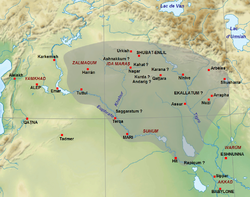Old Assyrian Empire
| Old Assyrian Empire | ||||||||||||||
| Aššūrāyu | ||||||||||||||
|
||||||||||||||
|
Map showing the approximate extent of the Upper Mesopotamian Empire at the death of Shamshi-Adad I c. 1721 BC.
|
||||||||||||||
| Capital |
Assur 2025 BC Shubat-Enlil 1754 BC Assur 1681 BC |
|||||||||||||
| Languages | Akkadian language, Sumerian language (declining) | |||||||||||||
| Religion | Ancient Mesopotamian religion | |||||||||||||
| Government | Monarchy | |||||||||||||
| išši’ak Aššur | ||||||||||||||
| • | c. 2025 BC | Puzur-Ashur I (first) | ||||||||||||
| • | c. 1378 BC | Ashur-nadin-ahhe II (last) | ||||||||||||
| Historical era | Bronze Age | |||||||||||||
| • | Established | 2025 BC | ||||||||||||
| • | Disestablished | 1378 BC | ||||||||||||
|
||||||||||||||
| Today part of |
|
|||||||||||||
The Old Assyrian Empire is one of four periods in which the history of Assyria is divided, the other three being: the Early Assyrian Period, the Middle Assyrian Period and the New Assyrian Period. Assyria was a major Mesopotamian Afro-Asiatic-speaking kingdom and empire of the ancient Near East. Centered on the Tigris-Euphrates River System in Upper Mesopotamia, the Assyrian people came to rule powerful empires at several times. Making up a substantial part of the "Cradle of Civilization", which included Sumer, the Akkadian Empire, and Babylonia, Assyria was at the height of technological, scientific and cultural achievements at its peak. At its peak, the Assyrian empire ruled over the what the ancient Mesopotamian religion referred to as the "Four Corners of the World": as far north as the Caucasus Mountains within the lands of what is today called the Republic of Armenia and the Republic of Azerbaijan, as far east as the Zagros Mountains within the territory of present-day Islamic Republic of Iran, as far south as the Arabian Desert of today's Kingdom of Saudi Arabia, as far west as the island of Cyprus in the Mediterranean Sea, and even further to the west in Egypt and eastern Lybia.
...
Wikipedia

